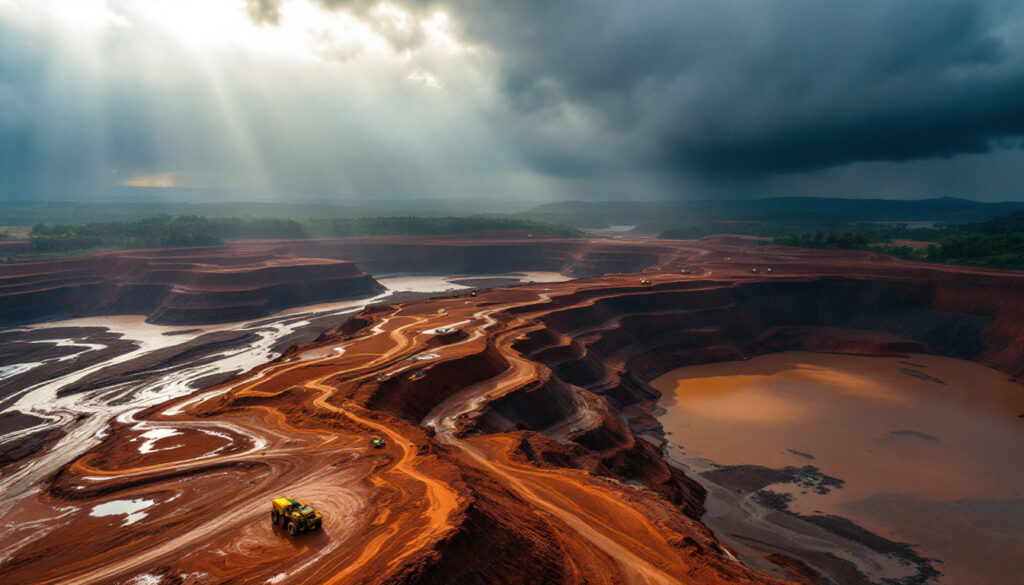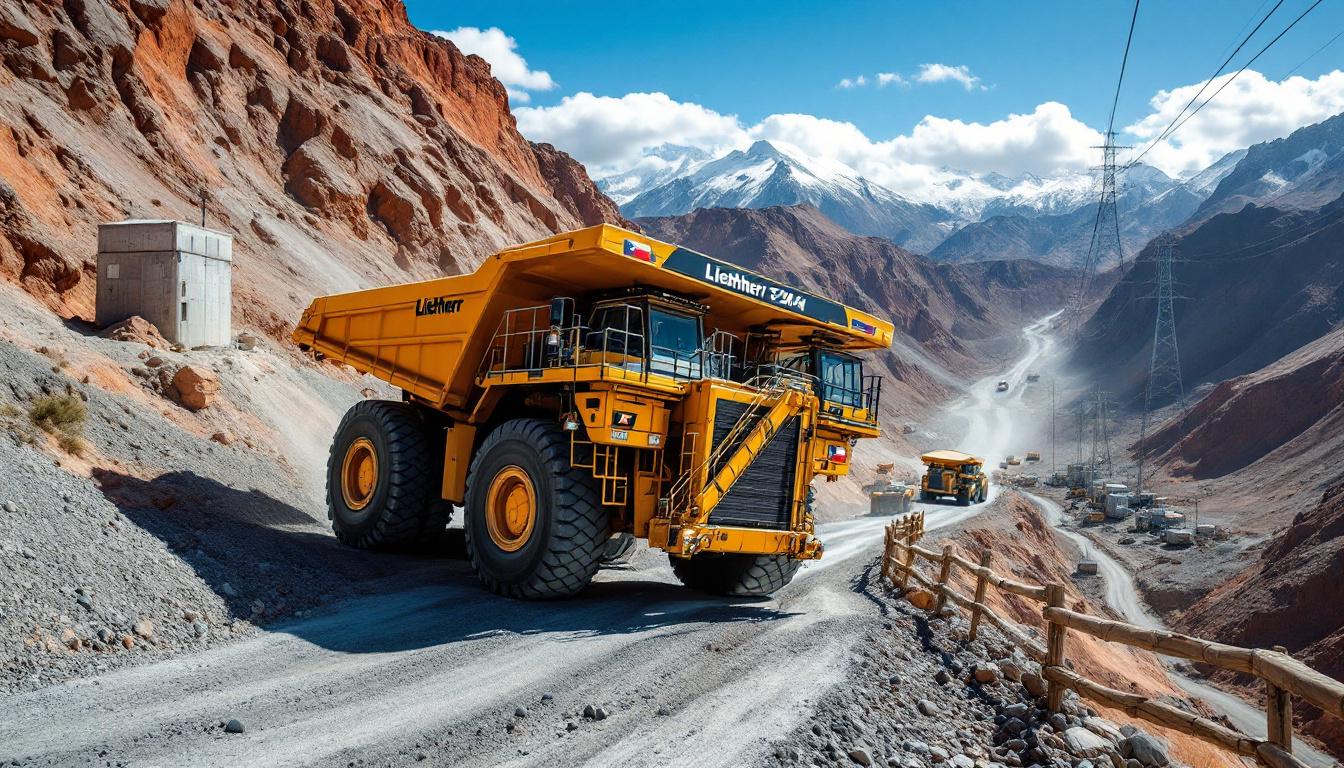How Has Heavy Rainfall Affected Vale's Iron Ore Production?
Vale's iron ore production faced significant challenges in the first quarter of 2025, with output reaching 67.7 million metric tons—a figure that fell substantially short of analyst expectations of 72.3 million tons. This 6.4% year-over-year decline from Q1 2024's 71.2 million tons highlights the substantial impact of seasonal weather patterns on mining operations in Brazil.
Brazil's rainy season, which typically spans from December through March, creates persistent operational hurdles for Vale, one of the world's largest iron ore producers. The mining regions of Minas Gerais and Pará can receive 1,500-2,000mm of rainfall annually, with the majority concentrated in this critical first quarter period.
"Seasonal rainfall patterns in Brazil create recurring logistical bottlenecks for open-pit mining, particularly in transportation and ore processing," notes mining analyst Mariana Durao. The impact extends beyond mere inconvenience—it represents a systemic challenge to Vale's production capabilities during these months.
Vale's Q1 2025 Production Results
The production shortfall stems directly from the excessive precipitation across Vale's key mining territories. While the company maintains its position as one of the world's top iron ore suppliers, these weather-related disruptions have significant implications for global supply chains that rely on steady Brazilian output.
Historical data shows this isn't an isolated incident. In Q1 2023, Vale's production dropped to a concerning 63.8 million tons amid record rainfall, resulting in approximately $220 million in delayed shipments and operational losses. While 2025's figures show improvement over that particularly challenging period, they still demonstrate the company's ongoing vulnerability to climate patterns.
The moisture content of extracted ore presents particular challenges. When water content exceeds 10%, crushing and screening efficiency drops dramatically, creating bottlenecks throughout the production process. Additionally, waterlogged access roads can delay truck fleet operations by 20-30% during peak rainy periods.
Impact of Brazilian Weather Patterns on Mining Operations
Open-pit mining, which constitutes the majority of Vale's operations, is inherently vulnerable to precipitation. Heavy rainfall increases pit wall instability, often necessitating the temporary suspension of excavation activities to ensure worker safety and prevent equipment damage.
Vale's northern operations, particularly the massive Carajás mining complex in Pará state, experience some of Brazil's most intense seasonal rainfall. These sites account for approximately 62% of Vale's 2025 projected output, making weather resilience in this region crucial to the company's overall production figures.
Water management becomes a critical operational focus during these periods. The company must carefully monitor tailings dams and water containment systems to prevent environmental incidents while maintaining production. These precautionary measures, while necessary, further constrain operational flexibility during wet months.
Historical Context of Vale's Production Challenges
Vale's production difficulties showcase a pattern of recurring weather-related disruptions in Brazilian mining operations. Unlike competitors in Australia's Pilbara region, which benefit from an arid climate allowing for 95% operational uptime, Vale's Brazilian operations average closer to 78% uptime during rainy seasons.
The company has developed adaptation strategies over decades of operating in these conditions. These include strategically scheduling maintenance during typically wet periods, building covered ore storage facilities, and implementing comprehensive water management systems. However, when rainfall exceeds historical averages, even these preparations prove insufficient.
Industry analysts note that Vale's reliance on aging infrastructure in northern Brazil exacerbates weather-related downtime. Many rail corridors and processing facilities were designed decades ago, before climate variability intensified, creating additional vulnerability to extreme weather events.
What Are the Market Implications of Vale's Production Shortfall?
Iron ore prices surge responded swiftly to Vale's production announcement, rising 8.2% to $132 per ton on global markets. This price sensitivity demonstrates the significant role Vale plays in global supply-demand dynamics, holding approximately 18% of the global seaborne iron ore market share.
The price response reflects both immediate supply concerns and broader market psychology. Traders recognize that Vale's Q1 challenges could have ripple effects throughout 2025, potentially creating tighter supply conditions during periods of strong demand.
"Vale's shortfall could tighten H2 2025 supply, amplifying price volatility as Chinese steel demand rebounds," according to a recent commodities analysis. This impact extends beyond raw material costs, as every $10 per ton increase in iron ore prices ultimately raises hot-rolled coil production costs by $15-$20 per ton, affecting downstream industries.
Global Iron Ore Supply Considerations
The production shortfall's timing is particularly significant as it coincides with forecasted increases in Chinese steel production. With China consuming over 70% of seaborne iron ore, any constraints in Brazilian supply can quickly translate to global price movements.
Historical precedent illustrates this relationship clearly. Following the 2019 Brumadinho dam collapse that severely impacted Vale's production, iron ore prices surged 24% within just one month. While the current situation isn't as severe, it demonstrates the market's sensitivity to disruptions from major suppliers.
Vale's competitors, particularly Australian giants Rio Tinto and BHP, maintain distinct operational advantages during these periods. Rio Tinto reported 84.3 million tons in Q1 2025, unaffected by weather disruptions, widening the production gap with Vale. This competitive positioning highlights the geographic advantage Australian producers enjoy.
As a CRU Group analysis recently noted, "Brazilian producers face three times more weather-related disruptions than Australian peers," creating an intrinsic competitive disadvantage that manifests most clearly during first-quarter results.
Investor Response to Production Results
Markets responded to Vale's production announcement with initial selling pressure, before stabilizing as analysts incorporated the news into longer-term forecasts. Several investment banks, including Citi Research, revised their 2025 iron ore price forecasts upward to $125-$140 per ton, from previous estimates of $118-$130.
Vale's stock valuation metrics remain attractive despite these challenges. Trading at approximately 5.2 times EBITDA versus a sector average of 6.8, according to UBS Mining Report, the company offers potential value for investors willing to weather short-term production volatility.
Analyst revisions to Vale's annual production forecasts have been measured rather than drastic. Most firms now project the company's 2025 output between 295-310 million tons, down from earlier estimates of 305-320 million, acknowledging both the Q1 shortfall and potential for recovery in drier quarters.
How Does Vale Plan to Address Production Challenges?
Vale has developed a comprehensive strategy to mitigate the impact of seasonal rainfall on its operations. The company has allocated $1.2 billion specifically for 2025 water management systems, representing a significant commitment to weather resilience across its Brazilian operations.
"Our new rail bypass in Pará will mitigate shipment delays during rainy seasons, ensuring 85% on-time delivery in 2025," Vale's CEO stated in a recent earnings call. This infrastructure investment addresses one of the most vulnerable links in the production chain—the transportation of ore from mines to port facilities.
These initiatives build on technological advancements already showing promise in pilot projects. Vale's AI-driven weather models, implemented in 2024 trials, reportedly reduced unplanned downtime by 15% by enabling more precise operational planning around precipitation events.
Vale's Production Recovery Strategy
The company's recovery strategy encompasses both immediate operational adjustments and longer-term infrastructure investments. In the near term, Vale is optimizing production schedules to maximize output during relatively drier periods within the rainy season, while concentrating essential maintenance during the most severe weather windows.
Vale's S11D mine in the Carajás complex offers a template for weather-resilient mining. Its automated haul trucks maintained 92% efficiency during the 2024 rainy season, significantly outperforming traditional operations. The company plans to expand these autonomous systems to additional sites in the coming years.
Logistics improvements represent another key focus area. Vale is enhancing its rail corridors with additional drainage systems, covered loading facilities, and track reinforcements to maintain consistent ore transportation during periods of heavy rainfall. These upgrades directly address a critical vulnerability in the production chain.
Engineering consultants note that "Vale's sludge pipeline upgrades cut water disposal costs by 30% in pilot sites," demonstrating both operational and financial benefits from these investments. The company appears committed to transforming a perennial challenge into an opportunity for operational advancement.
Technology and Innovation in Weather Resilience
Vale's approach to weather resilience increasingly relies on technological solutions. The company has deployed hundreds of real-time moisture sensors throughout its operations, optimizing processing plant throughput by precisely measuring and responding to changing ore conditions.
Elevated conveyor systems represent another innovative approach to reducing flood damage risks. By raising critical infrastructure components above potential flood levels, Vale can maintain basic operational capabilities even during extreme precipitation events.
Predictive weather technology integration has become a cornerstone of Vale's operational planning. Advanced meteorological modeling allows site managers to anticipate rainfall patterns with greater precision, enabling proactive rather than reactive management of weather challenges.
Water management systems implementation goes beyond mere operational concerns. Vale has developed closed-loop water systems that capture, treat, and recycle precipitation, turning a potential liability into a resource while reducing environmental impact and regulatory risks.
What Is Vale's Outlook for the Remainder of 2025?
Despite Q1 challenges, Vale maintains a cautiously optimistic outlook for the remainder of 2025. The company has revised its annual guidance to 295-310 million tons, down from the initial 305-320 million, acknowledging the impact of Q1 shortfalls while expressing confidence in recovery potential.
Vale's historical production patterns suggest significant recovery opportunities in the second half of the year. H2 production typically exceeds H1 by 12-18% during normal weather years, reflecting both seasonal advantages and operational adjustments made in response to first-half challenges.
"We anticipate Q3 output surpassing 80 million tons as our northern system expands," Vale's CFO stated during an investor presentation. This projection aligns with historical patterns, such as Vale's 2022 recovery when the company boosted second-half production by 22% following drought-impacted first-half results.
Production Forecasts and Guidance
Vale's production distribution across 2025 reflects both geological and logistical realities. Approximately 62% of 2025 output is expected to come from Sistema Norte's high-grade deposits, which generally contain iron content exceeding 65%, commanding premium prices on international markets.
The quarterly production distribution expected for the remainder of 2025 follows historical patterns but incorporates enhanced resilience measures. Vale projects Q2 production of 70-73 million tons, Q3 of 78-82 million tons, and Q4 of 78-82 million tons, with confidence in recovery potential increasing as drier conditions return.
The company's comparative analysis with previous years suggests 2025 will outperform 2023 (when total production reached 321 million tons) despite the challenging start. This optimism stems from operational improvements and infrastructure investments specifically designed to address weather vulnerabilities.
Strategic Priorities for Vale in 2025
Vale's strategic priorities extend beyond mere production recovery. The company has emphasized operational efficiency improvements, including energy optimization and maintenance scheduling refinements, to maximize output during favorable weather windows.
Market share protection represents another key strategic focus. With Australian competitors gaining ground during Brazil's rainy season, Vale is enhancing its customer service initiatives and quality control processes to maintain key relationships despite short-term delivery challenges.
Environmental and sustainability considerations increasingly influence Vale's production planning. The company has integrated environmental risk assessments into operational decision-making, recognizing that proper water management during heavy rainfall periods is essential for both production continuity and regulatory compliance.
Vale's carbon footprint management also factors into production planning. The company recognizes that production delays can actually increase per-ton emissions as fixed energy costs are spread across lower output volumes. This reality adds further incentive to develop weather-resilient mining practices through digital twin innovations.
FAQ About Vale's Iron Ore Production
How does rainfall typically affect iron ore mining operations?
Heavy rainfall impacts nearly every aspect of iron ore mining operations. In open-pit mines, precipitation increases safety risks through reduced visibility and potential pit wall instability. Mining equipment mobility becomes severely limited as haul roads turn muddy and potentially hazardous, reducing operational efficiency by 20-30% during peak rainy periods.
Ore processing faces particular challenges during wet seasons. Increased moisture content in extracted ore (exceeding 10%) reduces crushing and screening efficiency dramatically. This higher moisture content also increases energy requirements throughout the beneficiation process, raising operational costs.
Transportation and logistics experience significant disruptions during heavy rainfall. Rail lines can be affected by washouts or landslides, while port loading facilities may need to reduce operations during intense precipitation. The resulting bottlenecks can delay shipments by days or even weeks, affecting global supply chains.
Water management requirements intensify during rainy seasons. Mining operations must carefully balance water containment to prevent environmental incidents while maintaining sufficient drainage to continue operations. This balancing act requires sophisticated water management systems and constant monitoring.
How does Vale's production shortfall compare to other major iron ore producers?
Vale's weather-related production challenges create a distinct competitive disadvantage compared to its Australian competitors. Rio Tinto reported 84.3 million tons in Q1 2025, unaffected by weather disruptions, while BHP maintained steady production of approximately 68 million tons during the same period.
This disparity highlights the geographic advantage enjoyed by Australia's Pilbara region, where arid conditions allow for approximately 95% operational uptime throughout the year. In contrast, Brazilian operations average closer to 78% uptime during rainy seasons, according to industry analysts.
Vale's higher-grade ore (typically 65% iron content) partially offsets this production disadvantage, commanding premium prices that help maintain revenue despite lower volumes. Australian producers generally extract ore with 60-62% iron content, placing them in a different market segment.
Regional infrastructure also plays a role in production consistency. Australia's mining infrastructure was largely developed more recently than Brazil's, with weather resilience incorporated into initial designs rather than added retroactively. This fundamental difference contributes to the disparity in operational reliability.
What are the potential long-term implications for iron ore prices?
Iron ore market dynamics show clear sensitivity to Vale's production levels. Historical data indicates that a 1% reduction in Vale's output typically correlates with a 2.3% spot price increase, highlighting the company's outsized impact on global markets.
Supply-demand balance analysis suggests persistent tightness in high-grade ore markets if Vale's production challenges continue. With premium grades commanding increasing premiums for their environmental and efficiency advantages in steelmaking, Vale's high-quality Brazilian reserves remain strategically valuable despite weather challenges.
Historical patterns following production disruptions show market impacts lasting 3-6 months beyond the initial event. The 2019 Brumadinho dam collapse caused iron ore prices to surge 24% within a month, with elevated prices persisting for nearly a year as markets adjusted to reduced Brazilian supply.
Regional price differential considerations have become increasingly important. Chinese steel producers typically pay premium prices for Brazilian ore due to its higher iron content and lower impurities, making Vale's production levels particularly significant for high-end steel manufacturing markets.
The long-term price outlook remains contingent on Vale's ability to implement effective weather resilience measures. If the company can demonstrate consistent improvement in wet-season production, market confidence may reduce the price volatility currently associated with Brazil's rainy season, creating better conditions for navigating iron ore volatility and diversifying supply chains.
Ready to Be Alerted to the Next Major Mining Discovery?
Discover why significant mineral finds can lead to exceptional returns by exploring Discovery Alert's dedicated discoveries page, where their proprietary Discovery IQ model turns complex mining data into actionable investment insights before the wider market responds.




